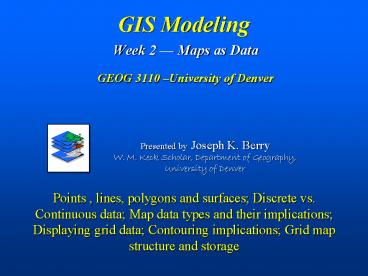GIS Modeling Week 2 - PowerPoint PPT Presentation
Title:
GIS Modeling Week 2
Description:
Title: No Slide Title Author: Joseph K. Berry Last modified by: Joseph K. Berry Created Date: 3/28/1997 5:15:08 PM Document presentation format: On-screen Show (4:3) – PowerPoint PPT presentation
Number of Views:116
Avg rating:3.0/5.0
Title: GIS Modeling Week 2
1
GIS Modeling Week 2 Maps as Data GEOG 3110
University of Denver
Points , lines, polygons and surfaces Discrete
vs. Continuous data Map data types and their
implications Displaying grid data Contouring
implications Grid map structure and storage
2
Who We Are (Class Photo)
3
Now, Where Were We?
- What GIS Is (and isnt)
- Computer Mapping (70s) - Spatial dB Management
(80s) - GIS Modeling (90s)
but we didnt finish last weeks material!!!
keeping in mind that the current frontier is
primarily focused on Multimedia Mapping (00s)
(Berry)
4
Campground Suitability Model Review (Logic)
Prefer Gentle Slopes, Near Roads, Near Water,
View of Water and Westerly Oriented but cant be
too close to water or too steep
(Berry)
5
Campground Suitability Model Review (Solution)
A sequencing of map analysis commands are applied
to implement model logicusing a command script
(Tutor25_Campground.scr)
(Berry)
6
Spatial Data vs. Spatial Information
- From GIS as a Toolbox enabling display and
geo-query to a Sandbox for developing,
communicating, interacting and evaluating
solutions to complex spatial problems - from Where is What to So What, Why and What If
(Berry)
7
Basic Map Features
(Berry)
8
Storing Points, Lines and Areas
how do you think Vector and Raster data
structures store Surfaces, Volumes, hyper-Volumes
and fuzzy-Features?
(Berry)
9
Spatial Resolution
The concept of Scale
S MD / GD (Map Distance / Ground Distance)
-
- does not exist in a GIS
replaced by the concept of Resolution (Spatial,
Mapping, Thematic and Temporal)
(Berry)
10
Minimum Mapping Resolution
replaced by the concept of Resolution (Spatial,
Mapping, Thematic and Temporal)
(Berry)
11
Thematic and Temporal Resolutions
replaced by the concept of Resolution (Spatial,
Mapping, Thematic and Temporal)
so what is the difference between the concepts
of PRECISION and ACCURACY and how do these
concepts relate to the concept of RESOLUTION?
(Berry)
12
Accuracy versus Precision
The Wikipedia defines Accuracy as the degree of
veracity (exactness) while Precision as the
degree of reproducibility (repeatable)
(Berry)
13
Classification versus Delineation (spatial
perspective)
Classification Accuracy (What) ?? Delineation
Precision (Where)
so what is the interpretation of PRECISION and
ACCURACY for Remote Sensing Classification maps?
(Berry)
14
Model Accuracy/Precision (spatial modeling
perspective)
Calibrate Expert Opinion
cognitive mapping has no definitive
right/wrong solution Most Preferred
Weight Stakeholder Values
(Berry)
15
Raster Data Types
(Berry)
16
Basic Grid Data Structure
The Analysis Frame provides consistent
parceling needed for map analysis and extends
discrete Point, Line and Areal features to
continuous Map Surfaces
17
Basic Grid Display Types
Display Types Lattice display forms a smooth
wireframe Grid display forms chunky extruded
grids
so how is a Contour Map generated? (vector
representation of a surface)
(See Example Applications, Display Types for
more information)
(Berry)
18
Thematic Display (Shading Manager)
MapCalc Shading Manager Ranges sets the
number of intervals Equal Ranges has the same
range for each interval (or Equal Count has the
same number of cells for each interval)
(See Example Applications, Display Types for
more information)
(Berry)
19
Contouring Mapped Data (Display Mode)
note the dramatic differences in the shape and
position of the boundary lines of the discrete
contour intervals
So which discrete map of the elevation surface is
CORRECT? are the differences in Precision or
Accuracy?
(Berry)
20
Matching Data Types Display Types/Forms
(See Example Applications, Data Types, Color
Interval/Pallet, 3D Display Options and Data
Inspection and Charting for related information)
(Berry)
21
Numeric and Geographic Data Types
all digital maps are composed of organized sets
of numbers the Data Type determines what
map-ematical processing can be done with the
numbers on a map, or stack of map layers
(Berry)
22
Homework Exercise 2
- Part 1 Understanding Basic Concepts and Terms
- Scale and Resolution. 1) Map Scale, 2) Spatial
Resolution, 3) Thematic Resolution, 4) Minimum
Mapping Resolution and 5) Temporal Resolution. - Data Types. 1) Nominal, 2) Ordinal, 3)
Interval, 4) Ratio, 5) Binary, 6) Choropleth, 7)
Isopleth data types (be sure to distinguish which
data types are Numeric and which are Geographic)
- Display Considerations. You will generate
different map displays of the Slope and Districts
map layers, then identify/comment on the Data
Type, Display Type and Display Form used and
discuss the effects/appearance of the different
displays
(Berry)
23
Simple Erosion Model
(Berry)
24
So Where Are You in GIS?
(See Beyond Mapping III, Topic 4, Where Is GIS
Education)
(Berry)
25
Vector to/from Raster (direct calculation)
(Berry)
26
Vector to Raster (centroid implied)
Note this technique is very sensitive to cell
size (features smaller than cells) and complexity
of boundary shape but it is really fast
(Berry)
27
Exporting MapCalc Data Layers
(Berry)
28
Grid-based Data Structures/Formats (Esri .asc)
(Berry)
29
Grid-based Data Structures/Formats (Surfer .grd)
(Berry)
30
Grid-based Data Structures/Formats (MapCalc .rgs)
(Berry)































